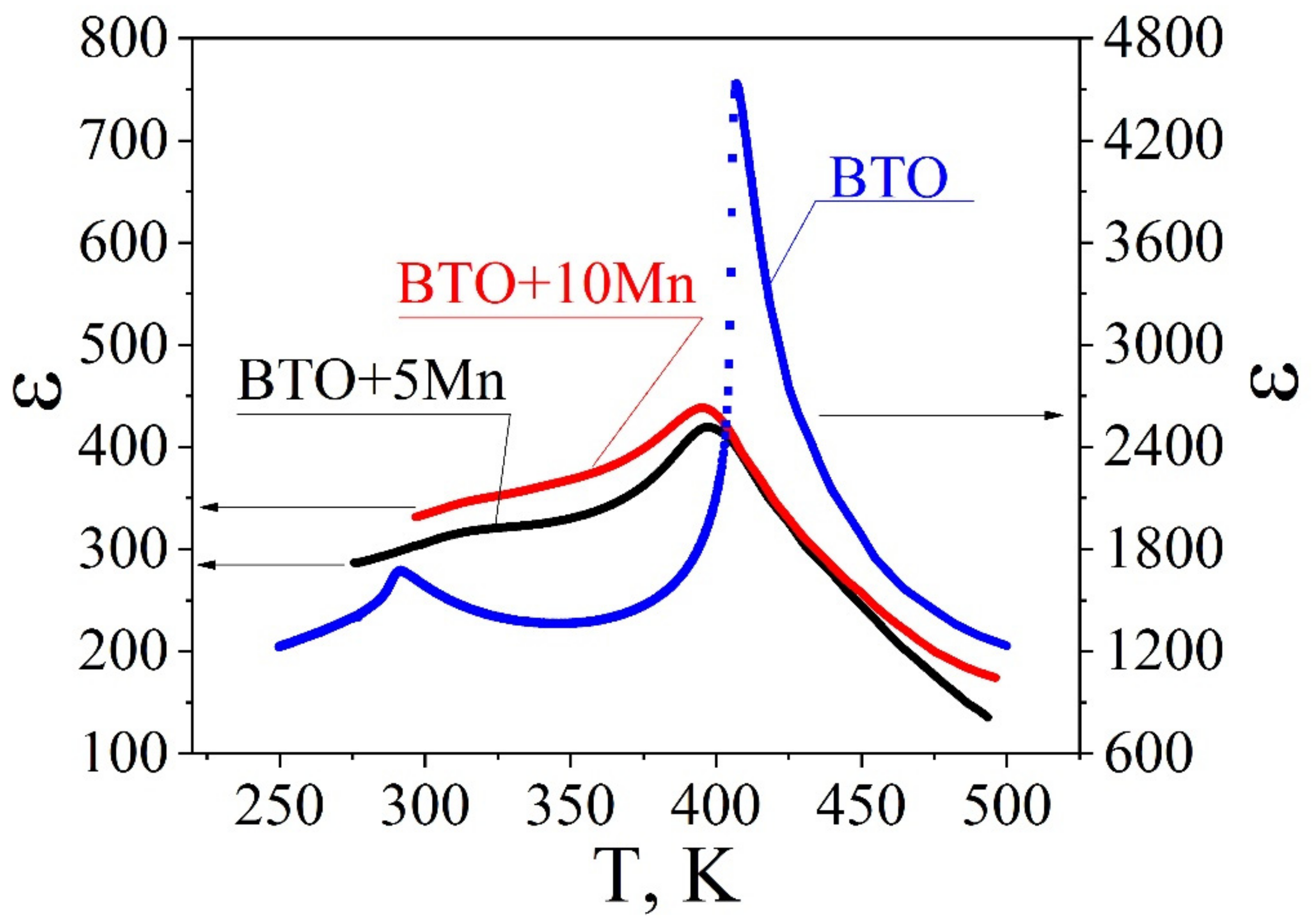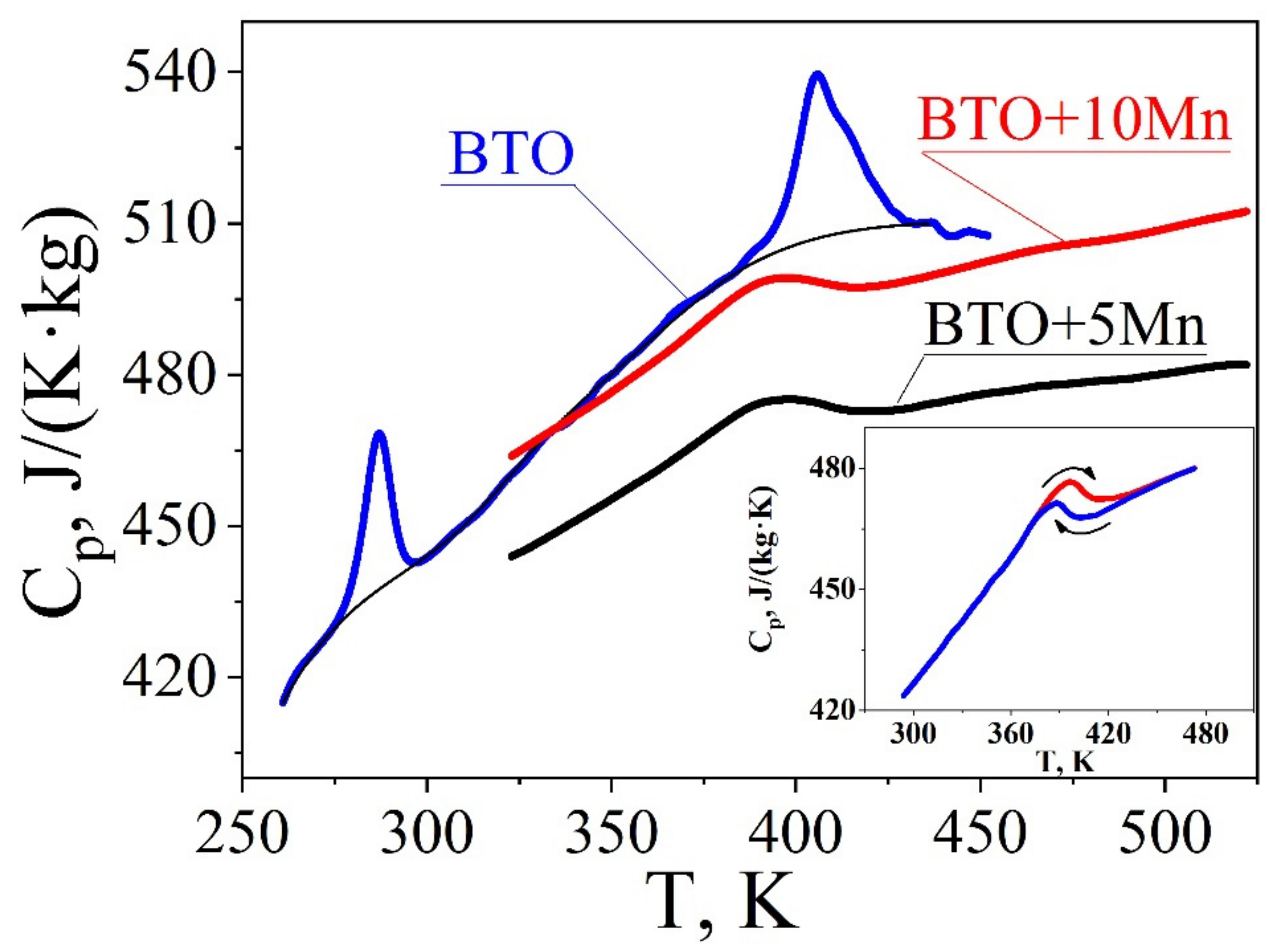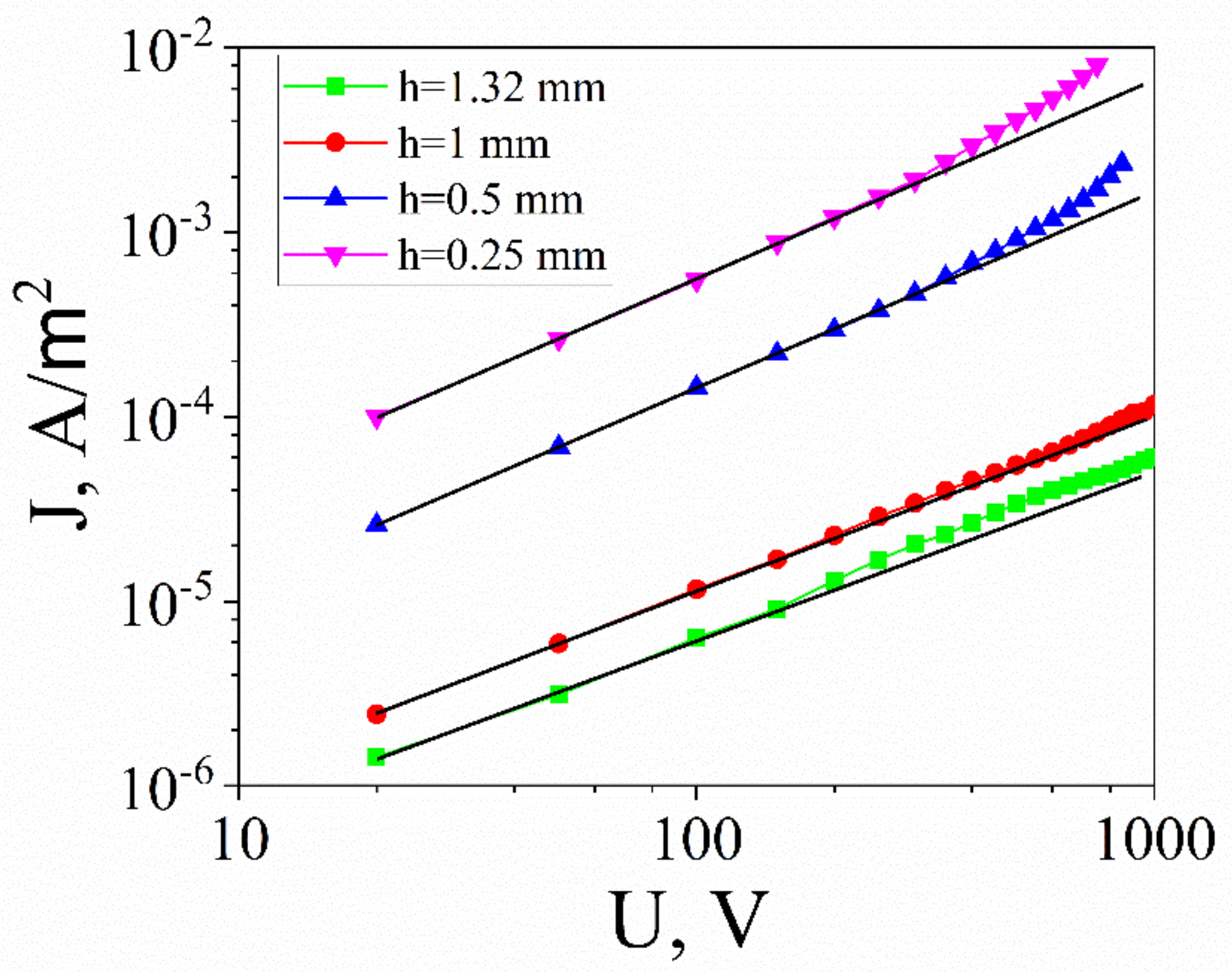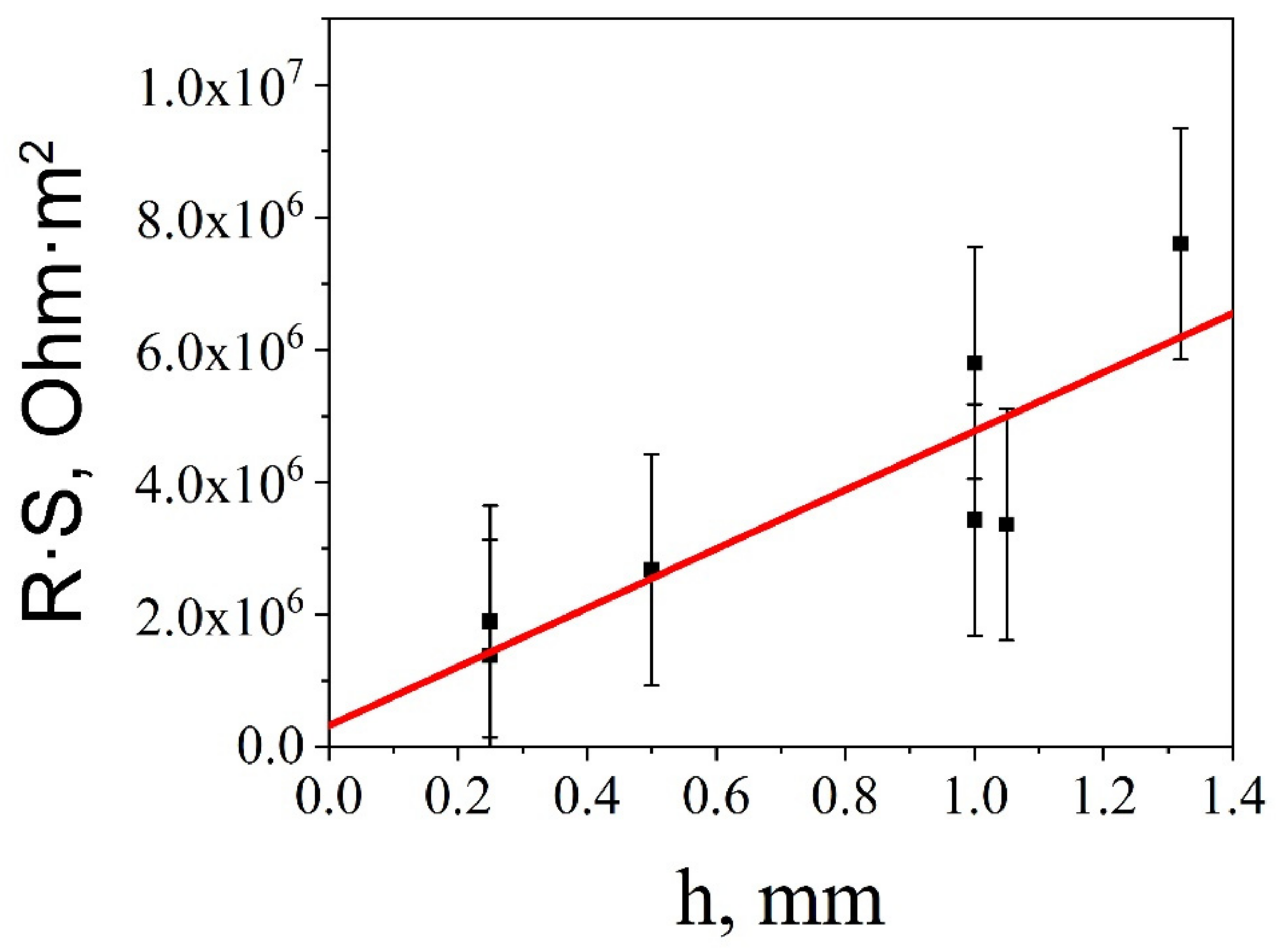Mn-Doped BaTiO3 Ceramics: Thermal and Electrical Properties for Multicaloric Applications
Abstract
:1. Introduction
2. Materials and Methods
3. Results and Discussion
3.1. Crystallograhic and Domain Structure
3.2. Dielectric Permittivity vs. Temperature Dependences
3.3. Specific Heat as a Function of Temperature and Doping
3.4. Conductivity at a High Electric Field
3.5. Discussion
4. Conclusions
Author Contributions
Funding
Acknowledgments
Conflicts of Interest
References
- Cheong, S.-W.; Mostovoy, M. Multiferroics: A magnetic twist for ferroelectricity. Nat. Mater. 2007, 6, 13–20. [Google Scholar] [CrossRef]
- Eerenstein, W.; Mathur, N.D.; Scott, J.F. Multiferroic and magnetoelectric materials. Nature 2006, 442, 759–765. [Google Scholar] [CrossRef] [PubMed]
- Nan, C.-W.; Bichurin, M.I.; Dong, S.; Viehland, D.; Srinivasan, G. Multiferroic magnetoelectric composites: Historical perspective, status, and future directions. J. Appl. Phys. 2008, 103, 031101. [Google Scholar] [CrossRef]
- Liu, M.; Zhou, Z. (Eds.) Integrated Multiferroic Heterostructures and Applications; John Wiley & Sons: Hoboken, NJ, USA, 2019; ISBN 978-352-734-177-1. [Google Scholar]
- Czernuszewicz, A.; Kaleta, J.; Lewandowski, D. Multicaloric effect: Toward a breakthrough in cooling technology. Energy Convers. Manag. 2018, 178, 335–342. [Google Scholar] [CrossRef]
- Kimura, T.; Kawamoto, S.; Yamada, I.; Azuma, M.; Takano, M.; Tokura, Y. Magnetocapacitance effect in multiferroic BiMnO3. Phys. Rev. B 2003, 67, 180401. [Google Scholar] [CrossRef]
- Goto, T.; Kimura, T.; Lawes, G.; Ramirez, A.P.; Tokura, Y. Ferroelectricity and giant magnetocapacitance in perovskite rare-earth manganites. Phys. Rev. Lett. 2004, 92, 257201. [Google Scholar] [CrossRef] [PubMed]
- Khomchenko, V.A.; Kiselev, D.A.; Kopcewicz, M.; Maglione, M.; Shvartsman, V.V.; Borisov, P.; Kleemann, W.; Lopes, A.M.L.; Araujo, J.P.; Rubinger, R.M.; et al. Doping strategies for increased performance in BiFeO3. J. Magn. Magn. Mater. 2009, 321, 1692. [Google Scholar] [CrossRef]
- Yang, C.H.; Kan, D.; Takeuchi, I.; Nagarajan, V.; Seidel, J. Doping BiFeO3: Approaches and enhanced functionality. Phys. Chem. Chem. Phys. 2012, 14, 15953. [Google Scholar] [CrossRef]
- Cheng, Z.X.; Li, A.H.; Wang, X.L.; Dou, S.X.; Ozawa, K.; Kimura, H.; Zhang, S.J.; Shrout, T.R. Structure, ferroelectric properties, and magnetic properties of the La-doped bismuth ferrite. J. Appl. Phys. 2008, 103, 07E507. [Google Scholar] [CrossRef]
- Khomchenko, V.A.; Kopcewicz, M.; Lopes, A.M.L.; Pogorelov, Y.G.; Araujo, J.P.; Vieira, J.M.; Kholkin, A.L. Intrinsic nature of the magnetization enhancement in heterovalently doped Bi1−xAxFeO3 (A = Ca, Sr, Pb, Ba) multiferroics. J. Phys. D 2008, 41, 102003. [Google Scholar] [CrossRef]
- Khomchenko, V.A.; Kiselev, D.A.; Vieira, J.M.; Kholkin, A.L. Synthesis and multiferroic properties of Bi0.8A0.2FeO3 (A = Ca, Sr, Pb) ceramics. Appl. Phys. Lett. 2007, 90, 242901. [Google Scholar] [CrossRef]
- Zhang, L.X.; Ren, X. Aging behavior in single-domain Mn-doped BaTiO3 crystals: Implication for a unified microscopic explanation of ferroelectric aging. Phys. Rev. B 2006, 73, 094121. [Google Scholar] [CrossRef]
- Ren, X. Large electric-field-induced strain in ferroelectric crystals by point-defect-mediated reversible domain switching. Nat. Mater. 2004, 3, 91. [Google Scholar] [CrossRef] [PubMed]
- Phan, T.-L.; Zhang, P.; Grinting, D.; Yu, S.C.; Nghia, N.X.; Dang, N.V.; Lam, V.D. Influences of annealing temperature on structural characterization and magnetic properties of Mn-doped BaTiO3 ceramics. J. Appl. Phys. 2012, 112, 013909. [Google Scholar] [CrossRef]
- Islam, R.; Choudhurya, S.; Rahmanb, S.N.; Rahman, M.J. Effect of manganese doping on the grain size and transition temperature of barium titanate ceramics. J. Ceram. Process. Res. 2012, 13, 248–251. [Google Scholar]
- Zhao, X.; Chen, W.; Zhan, L.; Gao, J.; Zhong, L. Effect of fabrication routes on the microstructure, the dielectric and ferroelectric properties of the Mn-doped BaTiO3 ceramics. Appl. Phys. A 2015, 118, 931–938. [Google Scholar] [CrossRef]
- Maldonado-Orozco, M.C.; Ochoa-Lara, M.T.; Sosa-Márquez, J.E.; Talamantes-Soto, R.P.; Hurtado-Macías, A.; Antón, R.L.; González, J.A.; Holguín-Momaca, J.T.; Olive-Méndez, S.F.; Espinosa-Magaña, F. Absence of ferromagnetism in ferroelectric Mn-doped BaTiO3 nanofibers. J. Am. Ceram. Soc. 2019, 102, 2800–2809. [Google Scholar] [CrossRef]
- Dang, N.V.; Phan, T.-L.; Thanh, T.D.; Lam, V.D.; Hong, L.V. Structural phase separation and optical and magnetic properties of BaTi1−xMnxO3 multiferroics. J. Appl. Phys 2012, 111, 113913. [Google Scholar] [CrossRef]
- Miyaura, A.; Kawaguchi, T.; Hagiwara, M.; Fujihara, S. Controlled 90° domain wall motion in BaTiO3 piezoelectric ceramics modified with acceptor ions localized near grain boundaries. SN Appl. Sci. 2019, 1, 286. [Google Scholar] [CrossRef]
- Madhan, K.; Jagadeeshwaran, C.; Murugaraj, R. Enhancement of electrical and magnetic properties in acceptor-doped BaTiO 3 ferroelectric ceramics. J. Mater. Sci. Mater. Electron. 2019, 30, 2953–2965. [Google Scholar] [CrossRef]
- Islam, S.; Siddika, A.; Khatun, N.; Hossain, M.S.; Begum, M.H.A.; Ahmed, N.A. Structural, dielectric and electric properties of manganese-doped barium titanate. Int. J. Nanoelectron. Mater. 2018, 11, 419–425. [Google Scholar]
- Karpinsky, D.V.; Troyanchuk, I.O.; Sikolenko, V.; Efimov, V.; Efimova, E.; Willinger, M.; Salak, A.N.; Kholkin, A.L. Phase coexistence in Bi1-xPrxFeO3 ceramics. J. Mater. Sci. 2014, 49, 6937. [Google Scholar] [CrossRef]
- Alikin, D.O.; Turygin, A.P.; Walker, J.; Bencan, A.; Malic, B.; Rojac, T.; Shur, V.; Kholkin, A.L. The effect of phase assemblages, grain boundaries and domain structure on the local switching behavior of rare-earth modified bismuth ferrite ceramics. Acta Mater. 2017, 125, 265. [Google Scholar] [CrossRef]
- Jona, F.; Shirane, G. Ferroelectric Crystals; Mir: Moscow, Russia, 1965; ISBN 978-048-667-386-8. [Google Scholar]
- Acosta, M.; Novak, N.; Rojas, V.; Patel, S.; Vaish, R.; Koruza, J.; Rossetti, G.A.; Rödel, J. BaTiO3—Based piezoelectrics: Fundamentals, current status, and perspectives. Appl. Phys. Rev. 2017, 4, 041305. [Google Scholar] [CrossRef]
- Kataoka, K.; Hayakawa, H.; Iyo, A.; Ken-ichi, O.; Akimoto, J. Synthesis, crystal structure and physical properties of Ba4Ti12O27. Key Eng. Mater. 2013, 566, 211–214. [Google Scholar] [CrossRef]
- Rzhanov, A.V. Titanat bariya—Novii segnetoelectric. Uspehi fizicheskih nauk 1949, 4, 461–489. [Google Scholar] [CrossRef]
- Strukov, B.A.; Ragula, E.P.; Stefanovich, S.Y.; Shnaidshtein, I.V.; Arkhangel’skaya, S.V.; Onodera, A. Ferroelectric phase transition in LaBSiO5 crystals from results of thermal and dielectric measurements. Phys. Solid State 1998, 40, 1193–1195. [Google Scholar] [CrossRef]
- Nye, J.F. Physical Properties of Crystals; Oxford University Press: Oxford, UK, 1957; ISBN 978-019-851-165-6. [Google Scholar]
- Shroeder, F. Poole-Frenkel-effect as dominating current mechanism in thin oxide films—An illusion?! J. Appl. Phys. 2015, 117, 215103. [Google Scholar] [CrossRef]
- Chang, S.T.; Lee, J.Y. Electrical conduction mechanism in high-dielectric-constant (Ba0.5,Sr0.5)TiO3 thin films. Appl. Phys. Lett. 2002, 80, 655–657. [Google Scholar] [CrossRef]
- Starkov, A.S.; Pakhomov, O.V.; Rodionov, V.V.; Amirov, A.A.; Starkov, I.A. Estimation of the thermodynamic efficiency of a solid-state cooler based on the multicaloric effect. Tech. Phys. Lett. 2018, 44, 42–49. [Google Scholar] [CrossRef]
- Gao, W.; Brennan, R.; Hu, Y.; Wuttig, M.; Yuan, G.; Quandt, E.; Ren, S. Energy transduction ferroic materials. Mater. Today 2018, 21, 771–784. [Google Scholar] [CrossRef]





| Sample | Main Phases | Mn Content |
|---|---|---|
| BTO | Tetragonal phase BaTiO3 | - |
| BTO+5Mn | Tetragonal phase BaTiO3 Monoclinic phase Ba4Ti12O27 | Ba(Mn0.02Ti0.98)O3 Ba4(Mn0.12Ti0.88)12O27 |
| BTO+10Mn | Tetragonal phase BaTiO3 Monoclinic phase Ba4Ti12O27 | Ba(Mn0.03Ti0.97)O3 Ba4(Mn0.14Ti0.86)12O27 |
| Composition of Ceramic Samples | K, K | Tc, K | ρ, kg/m3 | ΔQ, J/kg | ΔS, J/kg·K | P, C/cm2 | R, Ω |
|---|---|---|---|---|---|---|---|
| BTO | 0.88 × 105 | 407.7 | 5.65 × 103 | 584 | 1.434 | 11.2 × 10−6 | 1012 |
| BTO+5M | 0.8 × 104 | 397 | 5.05 × 103 | 246 | 0.620 | 2.1 × 10−6 | 4 × 1010 |
| BTO+10M | 0.15 × 105 | 395 | 4.65 × 103 | 258 | 0.653 | 2.83 × 10−6 | 2.4 × 1011 |
| BaTiO3 single crystal [28] | 401 | 899 | 2.24 | (16 − 24) × 10−6 | |||
| BaTiO3 single crystal [24] | 1.7 × 105 | 6.02 × 103 | 2.15 | 20 × 10−6 |
© 2019 by the authors. Licensee MDPI, Basel, Switzerland. This article is an open access article distributed under the terms and conditions of the Creative Commons Attribution (CC BY) license (http://creativecommons.org/licenses/by/4.0/).
Share and Cite
Semenov, A.; Dedyk, A.; Mylnikov, I.; Pakhomov, O.; Es’kov, A.; Anokhin, A.; Krylov, V.; Burovikhin, A.; Pavlova, Y.; Tselev, A.; et al. Mn-Doped BaTiO3 Ceramics: Thermal and Electrical Properties for Multicaloric Applications. Materials 2019, 12, 3592. https://doi.org/10.3390/ma12213592
Semenov A, Dedyk A, Mylnikov I, Pakhomov O, Es’kov A, Anokhin A, Krylov V, Burovikhin A, Pavlova Y, Tselev A, et al. Mn-Doped BaTiO3 Ceramics: Thermal and Electrical Properties for Multicaloric Applications. Materials. 2019; 12(21):3592. https://doi.org/10.3390/ma12213592
Chicago/Turabian StyleSemenov, Alexander, Antonina Dedyk, Ivan Mylnikov, Oleg Pakhomov, Andrey Es’kov, Alexander Anokhin, Vasiliy Krylov, Anton Burovikhin, Yulia Pavlova, Alexander Tselev, and et al. 2019. "Mn-Doped BaTiO3 Ceramics: Thermal and Electrical Properties for Multicaloric Applications" Materials 12, no. 21: 3592. https://doi.org/10.3390/ma12213592





